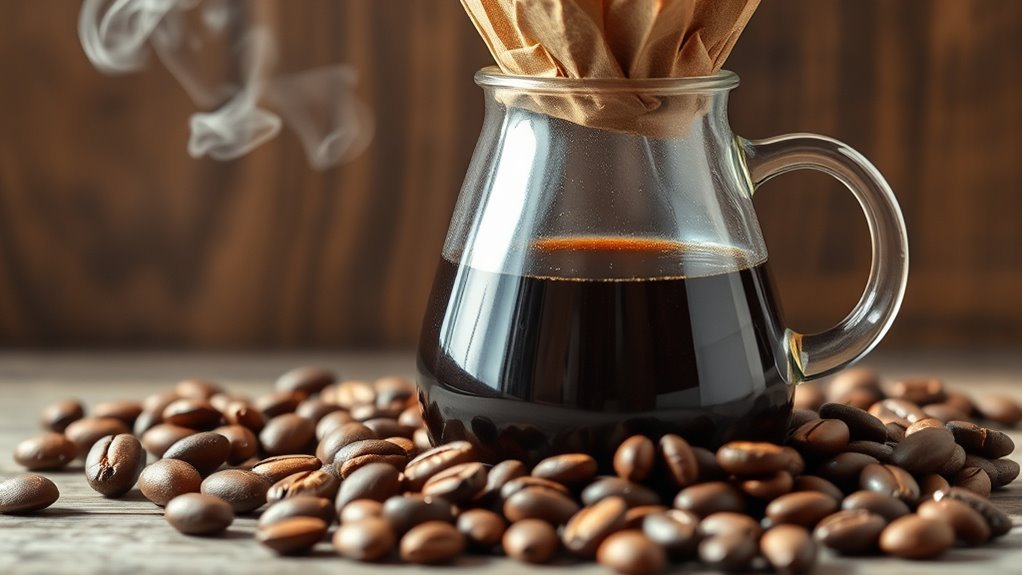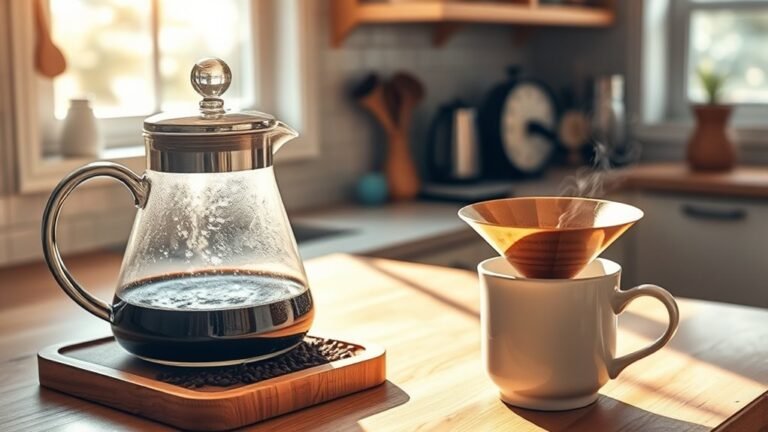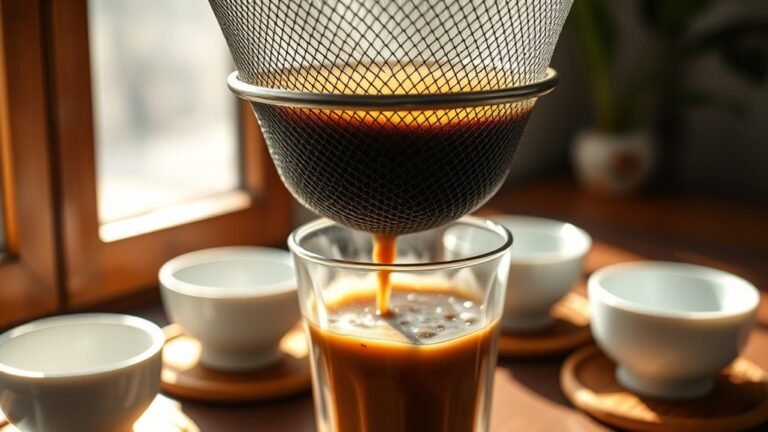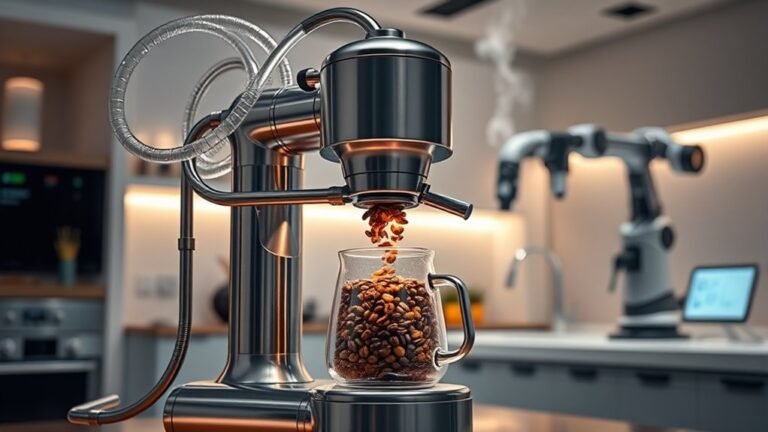The Best Decaf Coffee for Chemex
For the best decaf coffee in your Chemex, choose beans that balance clarity with rich flavor—look for fruity, nutty, or chocolatey profiles from Swiss Water or CO2 decaffeination methods to preserve complexity. Aim for medium roasts to enhance brightness without bitterness. Use a medium-coarse grind and brew between 195°F–205°F for ideal extraction. Proper storage in airtight containers retains freshness. If you want to achieve a clean, vibrant cup and elevate your experience, there’s plenty more to explore.
What Makes Decaf Coffee Ideal for Chemex Brewing
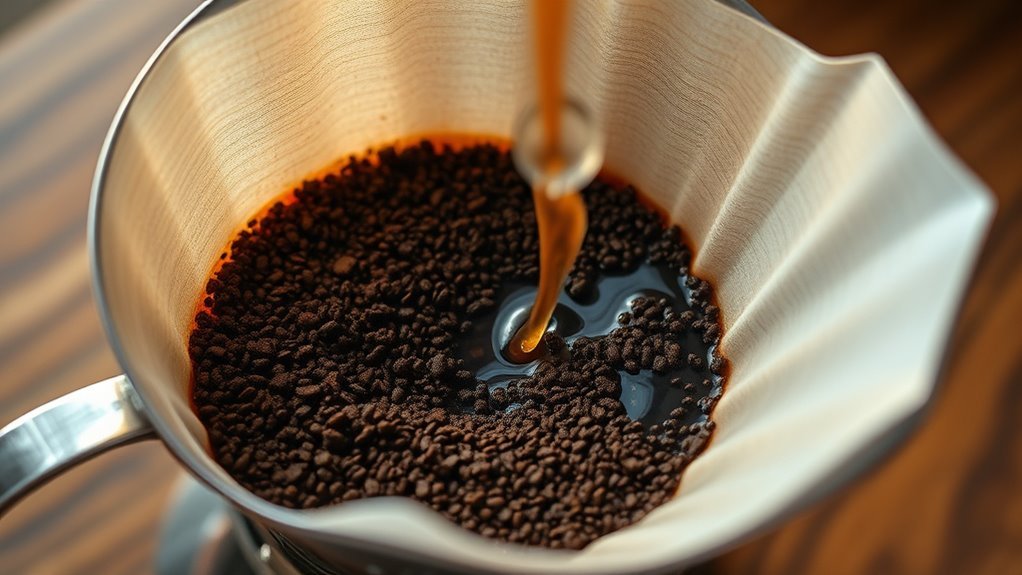
Although decaf coffee often faces skepticism from enthusiasts, it can actually be an excellent choice for Chemex brewing due to its unique chemical profile and extraction characteristics. When you brew with a Chemex, the control over brewing temperature becomes critical, as decaf beans respond differently than regular ones. Their lower caffeine content alters how solubles are extracted, meaning you’ll want to fine-tune your brewing temperature to optimize flavor extraction without over-extracting bitter compounds. The Chemex’s thick filter also plays a role, removing oils and sediments that could otherwise mute decaf’s nuanced flavors. By understanding these factors, you gain freedom to experiment confidently, ensuring the delicate balance between acidity and sweetness is maintained. This makes decaf coffee not just viable but ideal for your Chemex brewing method.
Top Flavor Profiles to Look for in Decaf Beans
When selecting decaf beans for your Chemex, focusing on specific flavor profiles can elevate your brewing experience considerably. You want to seek beans that maintain a rich decaf flavor and a vibrant coffee aroma, which are often diminished during decaffeination. Profiles with bright acidity, subtle fruitiness, and balanced nuttiness tend to perform well, preserving complexity and depth. Here’s a quick reference:
| Flavor Profile | Description | Ideal for Chemex |
|---|---|---|
| Fruity | Notes of berries or citrus | Enhances brightness |
| Nutty | Almond, hazelnut undertones | Adds smooth richness |
| Chocolatey | Cocoa hints | Deepens body and warmth |
| Floral | Jasmine, rose essence | Elevates aroma delicacy |
Choosing beans with these profiles guarantees your decaf brew won’t sacrifice the freedom of flavor you crave.
How the Decaffeination Process Affects Taste
You’ll notice that the decaffeination method plays a vital role in shaping your coffee’s flavor. Chemical processes often strip away more of the bean’s natural oils, leading to a flatter taste, while natural methods tend to preserve more complexity. Understanding these differences helps you choose decaf beans that complement the Chemex’s clean extraction style.
Common Decaffeination Methods
Since decaffeination methods vary widely, understanding how each process influences the flavor of your Chemex brew is essential. Decaf processing revolves around caffeine extraction techniques that impact the coffee’s chemistry and aroma. Here’s a concise look at common methods:
| Method | Solvent Used | Effect on Flavor |
|---|---|---|
| Swiss Water | Water (no chemicals) | Preserves natural flavors |
| CO2 Process | Supercritical CO2 | Targeted caffeine removal, clean taste |
| Methylene Chloride | Chemical solvent | Potentially alters subtle notes |
Each method offers a different balance between caffeine extraction efficiency and flavor retention, granting you freedom to choose decaf coffee that suits your Chemex preferences without sacrificing quality.
Impact on Coffee Flavor
The decaffeination method you choose directly shapes the flavor profile of your Chemex brew. Each process interacts uniquely with the coffee’s compounds, either preserving or muting delicate taste nuances. For instance, some methods better maintain the coffee’s inherent acidity and sweetness, essential for flavor balancing, while others may dull these elements, leading to a flatter cup. When you select decaf coffee, understanding how the process influences aroma and body helps you anticipate the final profile. You want a brew that retains complexity without bitterness or off-flavors, especially since Chemex’s clarity highlights subtle differences. Ultimately, the decaffeination’s impact on taste nuances defines whether your Chemex experience feels vibrant and free or muted and restrained—making your choice a significant factor in achieving your ideal cup.
Chemical vs. Natural Processes
Although both chemical and natural decaffeination processes aim to remove caffeine, they differ considerably in how they affect your coffee’s taste and aroma. Chemical extraction methods, like the Swiss Water Process or solvent-based techniques, often target caffeine with high efficiency but can inadvertently strip away some natural flavors, potentially dulling the coffee’s vibrant profile. On the other hand, natural decaffeination methods, such as using carbon dioxide, tend to preserve more of the coffee’s inherent aromatic compounds. When you brew decaf in your Chemex, these subtle differences become apparent—chemical extraction may yield a cleaner but slightly muted cup, whereas natural processes retain complexity and depth. Understanding these distinctions empowers you to choose a decaf that aligns with your taste freedom, ensuring your Chemex experience remains rich and satisfying.
Best Decaf Coffee Brands Compatible With Chemex
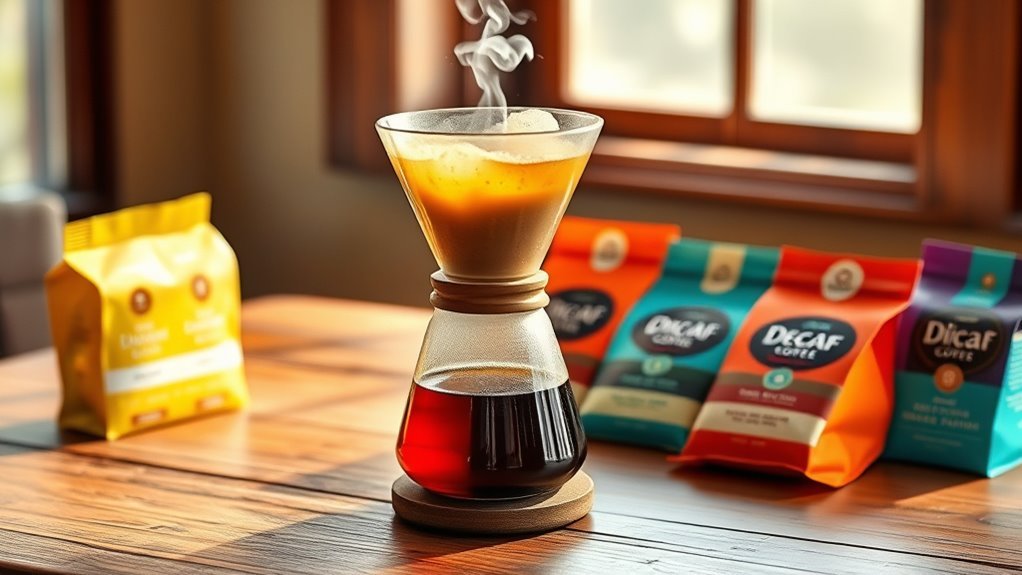
When selecting decaf coffee brands for your Chemex, pay close attention to flavor profiles that complement the method’s clarity and brightness. Understanding bean origins helps you anticipate nuanced tastes, while evaluating roast levels guarantees the coffee’s acidity and body align with your preferences. This approach lets you choose brands that optimize the Chemex’s unique extraction qualities.
Flavor Profiles Overview
Since decaf coffee often lacks the boldness of its caffeinated counterpart, choosing brands that maintain rich, nuanced flavor profiles is crucial, especially when brewing with a Chemex. You’ll find that decaf varietals vary greatly in their flavor nuances—some offer bright citrus notes, while others lean toward chocolatey or nutty undertones. The Chemex’s filtration emphasizes clarity, so selecting decaf beans with clean, well-defined profiles lets these subtleties shine through without bitterness or muddiness. When exploring decaf varietals, focus on those processed with methods preserving inherent flavors, like Swiss Water or CO2 decaffeination. This precision guarantees your cup delivers complexity and balance, granting you the freedom to enjoy a vibrant coffee experience even without caffeine. Ultimately, your choice of decaf directly shapes the Chemex’s potential for flavor expression.
Bean Origin Insights
Understanding the origin of your decaf beans is key to revealing the full potential of your Chemex brew. Different bean varieties from specific origin regions impart distinct characteristics that influence aroma, acidity, and body. For instance, decaf beans from Ethiopian origin regions often offer floral and citrus notes, while those from Central American regions present balanced sweetness and nutty undertones. By selecting decaf coffee from carefully sourced origin regions, you guarantee clarity and complexity in your cup. You’ll want to focus on bean varieties known for retaining flavor post-decaffeination, such as Arabica cultivars adapted to these regions. This approach not only elevates your Chemex experience but also grants you the freedom to explore nuanced profiles without caffeine’s interference. Choosing wisely here sets the foundation for exceptional decaf brewing.
Roast Level Comparisons
Selecting the right roast level is essential for maximizing the flavor extraction in your Chemex when brewing decaf coffee. Light decaf roasts preserve the bean’s origin characteristics, offering brighter acidity and nuanced floral or fruity notes, but they demand precise brewing to avoid under-extraction. Medium decaf roasts strike a balance, enhancing sweetness and body while maintaining moderate flavor intensity, making them versatile for Chemex. Dark decaf roasts deliver bold, smoky profiles with reduced acidity and a heavier mouthfeel; however, they can mask subtle flavors and risk bitterness if over-extracted. Understanding how roast level influences flavor intensity allows you to tailor your decaf choice to your taste freedom, ensuring each Chemex brew aligns with your preferred balance of clarity, depth, and complexity.
Grinding and Brewing Tips for Decaf Chemex Coffee
Mastering the grind size is essential when brewing decaf coffee with a Chemex, as it directly affects extraction and flavor balance. For decaf, aim for a medium-coarse grind—too fine, and you risk over-extraction bitterness; too coarse, and under-extraction leads to weak, sour notes. Your brewing temperature should hover between 195°F and 205°F to optimize solubility without degrading delicate decaf compounds. Pre-wet the filter to eliminate paper taste and allow even saturation. Pour water in slow, controlled spirals to maintain consistent extraction and avoid channeling. Since decaf beans can be denser, adjust your grind and brewing time slightly if you notice imbalance. By fine-tuning grind size and temperature, you’ll reveal a clean, vibrant cup that honors decaf’s unique profile while preserving your freedom to savor every sip.
Storing Decaf Coffee to Preserve Freshness
Once you’ve dialed in the grind and brewing parameters for your decaf Chemex coffee, the next step is to guarantee your beans stay fresh over time. Proper storage is vital to maintain flavor and aroma. Here are essential freshness tips to keep in mind:
- Use airtight storage containers: Opt for opaque, airtight containers that block light and oxygen to slow oxidation, preserving your beans’ volatile compounds.
- Store in a cool, dark place: Avoid heat and humidity, which accelerate staling. A pantry or cupboard away from appliances works best.
- Avoid frequent exposure to air: Only open your container when necessary. Think about portioning beans into smaller batches to minimize air contact.
Enhancing Your Chemex Decaf Experience With Pairings

Although decaf coffee has a subtler flavor profile than its caffeinated counterpart, pairing it thoughtfully can elevate your Chemex experience considerably. To truly appreciate the nuances, choose decaf food pairings that complement and highlight its delicate notes. Light pastries, such as almond croissants or shortbread, bring out subtle sweetness, while citrus fruits can brighten the coffee’s natural acidity. Nut-based snacks enhance the earthy undertones often present in decaf. Avoid overpowering flavors, as they mask the coffee’s subtlety rather than enhancing flavors. Experiment with mild cheeses or dark chocolate in small amounts to find your perfect balance. By curating pairings mindfully, you gain freedom to explore and deepen your Chemex decaf ritual, transforming a simple brew into a refined sensory experience.
Frequently Asked Questions
Can I Use the Same Chemex Filter for Regular and Decaf Coffee?
Yes, you can use the same Chemex filter for both regular and decaf coffee because Chemex filters are designed for universal filter compatibility. However, to truly appreciate each brew’s unique flavor, consider how your brewing techniques might affect extraction. Cleaning your Chemex thoroughly between uses guarantees no residual flavors mix. This way, you maintain freedom in your coffee choices without compromising the purity of either regular or decaf cups.
How Long Does Decaf Coffee Stay Fresh After Opening?
Imagine your decaf coffee as a delicate melody that fades if not cherished properly. After opening, decaf storage becomes essential; exposure to air, light, and moisture steals its freshness. You’ll find your coffee freshness peaks within two weeks when kept in an airtight container, away from heat and sunlight. Treat it like a fleeting moment—preserve it well, so every cup sings with freedom and flavor, unburdened by staleness.
Is Decaf Coffee Healthier Than Regular Coffee?
You might wonder if decaf coffee is healthier than regular coffee. Decaf benefits include lower caffeine, which eases jitters and reduces heart rate spikes, addressing some health concerns linked to caffeine sensitivity. However, it still contains antioxidants and nutrients, so you won’t miss out on those perks. Ultimately, the health difference depends on your body’s reaction to caffeine and your personal health goals, giving you freedom to choose what suits you best.
What Water Temperature Is Best for Brewing Decaf in a Chemex?
When brewing decaf in your Chemex, aim for water around 195-205°F to optimize flavor extraction. This temperature range guarantees balanced brewing techniques, preserving decaf’s subtle notes without bitterness. If the water’s too hot, you risk over-extraction; too cool, under-extraction. So, controlling temperature gives you freedom to highlight decaf’s unique profile, letting you enjoy a smooth, flavorful cup every time. Adjust slightly based on your taste preferences.
Can I Mix Decaf and Regular Coffee Beans in My Chemex?
Imagine blending 50% decaf blends with 50% regular beans to tailor your caffeine intake. You can definitely mix decaf and regular coffee beans in your Chemex. The key is adjusting coffee ratios precisely to balance flavor and caffeine. Start with a 1:1 ratio, then tweak based on taste and strength. This approach gives you freedom to customize your brew, enjoying the best of both worlds in one aromatic cup.
